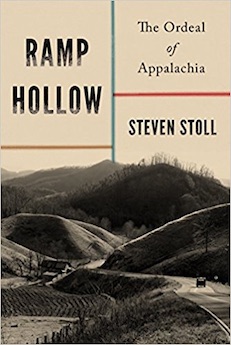Shortlisted for the 2018 Ralph Waldo Emerson Award
By Allen D. Boyer
On official maps, the mountains and poverty of Appalachia stretch from southwestern New York to northeastern Mississippi. Rather than measure elevation or income, however, Steven Stoll locates the region as a place in history:
“The southern mountains are half a billion years old but Appalachia did not exist before the industrial invasion of those uplands during the nineteenth century. . . . It was created and constantly re-created by hunters and farmers of every ethnicity who employed the landscape for subsistence and exchange; by land-engrossing colonial elites; by corporate attorneys scheming to get hold of deeds; by investors wielding cadastral maps; by coal miners resisting company managers and starving on strike; by the social engineers of the New Deal; by the Appalachian Regional Commission; and by brokenhearted citizens watching beloved hollows buried by mountaintop-removal mining.”
This book is a history of Appalachia and a history of how we have visualized Appalachia. It is about how American business has dispossessed mountain people and how American culture has made that easy by mocking them.
In the narrative that Stoll hammers home, mountain people lived simply, but rarely starved. Mountaineers became impoverished only when they lost the ecological base upon which they lived—bottomlands where they raised crops, balds where they pastured cattle, hollows where they cut timber for cabins and firewood. Afterwards, they became poor enduringly, crushed to the bottom of a cash economy.
“Poverty on such a scale is only comprehensible historically,” Stoll warns; “nothing about the history of the southern mountains can be explained as social evolution.” Rather, the pervasive poverty of Appalachia is the other side of a rapacious industrial drive to make money out of the lands on which mountaineers live. “The central event in Ramp Hollow is the scramble for Appalachia, or the rapid onslaught of joint-stock companies to attain the rights and ownership needed to clear-cut the forests and dig out the coal.”
George Washington had squatters ejected from mountain land to which he held title. Alexander Hamilton imposed an impossible tax on rye whiskey and marched troops into the mountains to collect it. As the Gilded Age fired up, coal seams were discovered under West Virginia. Mountaineers had traded land among themselves. They had filed few deeds. Taking advantage of every gap in the record, land trusts challenged or bought up titles—getting hold of timber and mineral rights.
By 1890, mountaineers had been written off as “Hill-Billies,” poor, careless, and “natural,” given of course to drinking and gunplay, people too shiftless to step out of the way of progress. “Foresters, economists and New Dealers had a word for [their] farms: submarginal,” Stoll scathingly comments. Arnold Toynbee pronounced Appalachians a “melancholy spectacle . . . a people who have acquired civilization and then lost it.”
This stereotyping has denigrated mountain people and misled professors. It has meant that the bloodiest chapter in mountain history has been misunderstood—mistaken for a picturesque hillbilly squabble. The Hatfield-McCoy feud of the 1880s was not a series of shoot-outs between backcountry families. It was the Appalachian version of a range war. In the hollows where the Norfolk & Western Railway was building branch lines, William Anderson “Devil Anse” Hatfield was a rough-edged businessman, an operator notorious for lawsuits and shady land deals. The gunmen who followed him came mostly not from his kith and kin, but from his logging crew.
Appalachia touches a dozen states but includes completely only one, West Virginia. Outside Morgantown, in the valley of Ramp Hollow, Stoll centers his book. Once a meadow where mountaineers gathered wild onions—close to Arthurdale in Scotts Run, where a New Deal “model town” experiment failed—the valley is a place of ruined cabins. Their lonely chimneys cast shadows over this book.
Ramp Hollow surveys more than Appalachia. It is also a history of agrarians, people who subsist on family farms and shared common lands, and how they have been dispossessed. Stoll remembers other embattled agrarians: English copyholders resisting enclosure; freedmen in the Deep South, slaves no longer but forced by planters to grow cotton, a cash crop; West African villagers battling sugar company plans to turn ancient village communes into company towns.
In long years of research, Stoll sadly remarks, “I often came across an idea that amazed me but that I could not understand, the idea that historical progress required taking land away from agrarians and giving it to others.” He has exposed that pernicious makeweight justification in this outraged, learned, generous book.
Allen D. Boyer (ΦBK, Vanderbilt University, 1977), a native of Mississippi who lives and writes in New York City, has countless times driven the length of District Twelve along Interstate 40 and Interstate 81. Vanderbilt University is home to the Alpha of Tennessee Chapter of Phi Beta Kappa.




